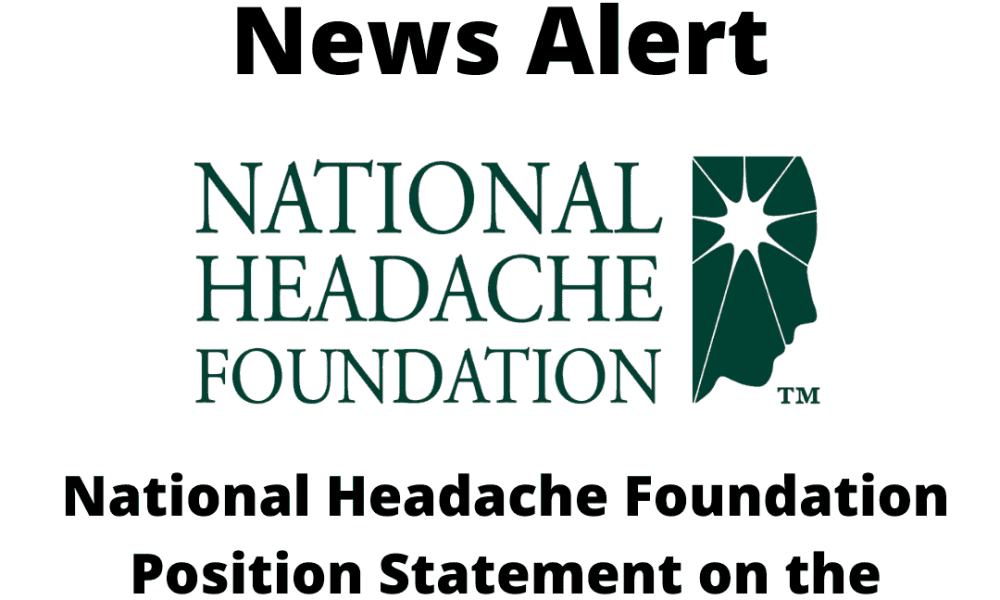Older prescription drugs in a stepwise approach needs health insurance overhaul
WV Press Release Sharing
CHICAGO, Ill. – Tom Dabertin, Chief Executive Officer/Executive Director of the National Headache Foundation (NHF) is calling on members of Congress and regulatory agencies to conduct oversight of health insurance payers for uneven treatment of migraine patients. On Jan. 19, NHF issued a science-based statement to medical journals and the media, arguing “current care models have not kept pace with the many advances in treatment.”
The week of Jan. 24, NHF sent its fact-filled statement on current models of migraine care to every member of Congress.
Dabertin said the influx of supportive comments from thousands of migraine patents, trade publications, and sister non-profit organizations advocating for prevention and improvements in headache and migraine diagnosis and treatment demonstrates both the need and support for this initiative.
According to Dabertin, “Healthcare providers and patients are frustrated that payers are forcing them to use older medications, some of which are not even designed for the specific treatment of migraine, even though new migraine-specific therapies now exist. To enhance provider-patient collaborative care, the NHF advocates those payers adopt care models that are patient-centric, where the clinician in collaboration with the patient, is the primary decision-maker and selects a treatment that addresses the patient’s treatment goals and needs.”
Dabertin encourages policy makers, regulatory bodies, and patient advocates to digest and act on the NHF statement at https://headaches.org/2022/01/19/national-headache-foundation-position-statement-on-the-treatment-of-migraine/
The message is pasted below:
# # #
About the National Headache Foundation
The National Headache Foundation (NHF) is the leading educational and informational resource for individuals with headache, their families, physicians, allied health care professionals, and health policy decision makers. For more information on the National Headache Foundation, please visit www.headaches.org.
National Headache Foundation Position Statement on the Treatment of Migraine
Thomas Dabertin, Executive Director/CEO
National Headache Foundation
[email protected]
The vision of the National Headache Foundation (NHF) is “a world without headache.” In support of this mission, the NHF focuses on four key goals: Awareness, Advocacy, Education, and Research. These goals place patients at the heart of everything we do.
In keeping with our mission and vision, we believe headache and migraine patients are best served by a patient-centric model of care, in which the clinician is empowered to select the right treatment for the right patient at the right time. NHF also endorses and advocates for the right of the patient’s voice and opinion to be included in determining the most appropriate treatment.
To that end, our position is that the selection of a migraine therapy:
- Should ultimately be determined by the clinician, in collaboration with the patient, based on the individual needs of that patient and that patient’s outcomes
- Should not be determined solely by a step-care model
- Should not be determined by a one-size-fits-all algorithm, including models focused predominantly on costs instead of outcomes
This Position Statement describes our reasoning for these three key messages and offers our specific recommendations for a patient-centric, stratified approach to migraine care.
In the future, NHF will expand upon this Position Statement and propose specific treatment guidelines.
Care models for migraine must reflect scientific and clinical advances
The scientific understanding of migraine has advanced considerably in recent years, bringing better tolerated and better-studied treatments to patients – most notably, anti-CGRP monoclonal antibodies (mAbs), oral CGRP antagonists (gepants), and agents targeting serotonin receptors. There is also growing awareness among clinicians that what was once thought sufficient efficacy for successful migraine control is, in fact, inadequate.
Unfortunately, the care models set by payers and the consequent treatment paradigms have not kept pace with these advances. For patients who are highly impacted or disabled by migraine, clinicians should not be directed to deliver outdated models of care that apply a predetermined algorithm in a stepwise approach to all patients, without considering the needs of the individual patient, and that encourage the use of older preventive drugs when targeted and migraine-specific therapies now exist. Many of the older preventive drugs have never been studied in large, randomized, double-blind placebo-controlled trials[1],[2],[3],[4] and/or do not have FDA approval for their use in the treatment of migraine.[5] Many of these preventive drugs have lower tolerability than the newer agents (e.g., topiramate vs. erenumab[6]). Furthermore, their side effects have often been found to result in high discontinuation rates[7],[8] which, ultimately, may prolong the impact of migraine and put many patients at risk of transformation to chronic migraine or, at the very least, higher frequencies and severity of their attacks.
Rigid step-care models of migraine treatment require patients to try two established medications in succession, which may include drugs not developed specifically for migraine or FDA-approved as migraine preventives and require use for a period of 1-4 months each. If the patient has shown inadequate responses to the two drugs after the trial periods have expired, only then may they be prescribed treatments based on the clinician’s discretion.
For preventive care, NHF believes it is inappropriate to require all patients to follow this “try two and fail” model before they may be offered treatment with any FDA-approved migraine preventive, including neuromodulation devices, with established lower adverse event profiles. Patients and their clinicians will be able to discern whether or not a newer preventive agent is providing the expected benefit much sooner, as that is a characteristic of these newer agents, e.g., mAbs and gepants.
Tolerability may also be assessed more quickly. Furthermore, the older preventive medications have established contraindications that often preclude their use in some migraine patients, e.g., cognitive capacity, reproductive status, tremor, and renal insufficiency. As noted previously, some of these non-specific preventive medications may have intolerable and unacceptable side effects for the migraine patient population, e.g., exercise intolerance, weight gain, orthostasis, or bradycardia.
NHF has other specific concerns and objections regarding the “try two and fail” policy which:
- Ignores the evidence that migraine is a genetic, heterogeneous disease and instead treats all patients as if they were the same by applying a single set of criteria to the entire spectrum of migraine phenotypes, which can vary both in treatment response and tolerance of side effects.
- Lacks or is inadequately supported by data showing a positive impact for many commonly used preventive medications on healthcare utilization (HCU) and costs incurred because of ineffective preventive treatment of migraine (g., outpatient care, hospital admissions, ER visits); whereas recent studies have showing CGRP-targeting therapies can reduce HCU.[9],[10],[11],[12]
- Does not consider the disability patients may potentially suffer in their work, social, and family lives when migraine treatment is ineffective or inadequate.
- May not effectively manage the symptoms that patients have reported as most bothersome to them, such as photophobia, nausea, tinnitus, cognitive performance, vertigo, and dizziness.[13]
- May not enable patients to achieve meaningful outcomes, which are defined by more than a simple reduction in days with migraine, g., reduction in lost workdays, productivity on the job, increased participation in social and family life, and a greater sense of control over their disease.
Additionally, the “try two and fail” policy uses language that stigmatizes patients as having failed when they do not receive the expected benefit of a drug. Instead, NHF endorses the use of language acknowledging the reality that, when the patient does not receive the expected benefit of a drug, it is the drug that has failed the patient.
NHF recommendations for preventive and acute migraine care
NHF endorses care models that are patient-centric, where the clinician, in collaboration with the patient, is the primary decision-maker and selects a treatment that addresses the patient’s treatment goals and needs.
Preventive care model with defined thresholds for migraine-related impairment
For preventive therapies, NHF endorses a patient-centric, stratified care model that takes into account the degree to which migraine episodes adversely affect a patient’s ability to function, work and interact with others. Specifically, the greater the number of migraine days per month (as defined below) that the patient experiences, the greater the discretion that the clinician should have in selecting an appropriate preventive therapy.
NHF supports the ability of primary care clinicians, which in some states include nurse practitioners and physician assistants, to prescribe preventive drugs. Further, given the paucity of headache specialists in the United States, we do not endorse a requirement that newer FDA-approved migraine preventive and acute therapies be limited to use by specialists alone.
NHF views a migraine day as a standard 24-hour day during which a patient’s ability to function is interrupted or impaired by any symptom or group of symptoms of migraine, including aura, headache pain, photophobia, phonophobia, nausea, vomiting, and/or other prodromal or postdromal symptoms. This acknowledges that (1) headache pain is not the only symptom that causes patient impairment; (2) migraine symptoms lasting more than one day can result in multiple days of impairment; and (3) the definition of “migraine day” should include patients who manage to function despite severe pain, as well as patients who have no pain but still cannot function because of associated migraine features.
Specific recommendations
For patients with a minimum of eight (8) migraine days per month, which constitutes high-frequency or chronic migraine, NHF recommends that the clinician have the ability to select the most suitable preventive therapy, with unfettered access to FDA-approved preventive drugs, because: (1) eight or more migraine days constitutes a significant fraction (25% or more) of the month; (2) patients with less time to recover between incidents are more likely to experience a transformation to chronic migraine (more than 15 days per month), and (3) studies suggest patients with 8-14 headache days/month have a level of disability similar to those with 15-19 headache days/month.[14]
For patients with a four to seven (4-7) migraine days per month, NHF recommends a modified step-care model, in which patients must first try one generic drug for migraine prevention from the following list, unless a patient has a contraindication or, in the clinician’s judgment, the patient should not receive it:
- Topiramate *
- Divalproex *, sodium valproate *
- Timolol *
- Propranolol *
- Candesartan
- Metoprolol
- Venlafaxine
- Nortriptyline
- Amitriptyline
where * denotes those drugs that are FDA-approved for migraine prevention,[15] and the remaining drugs are commonly used, but not FDA-approved, for that indication.
If a drug from this list has failed to provide the patient with benefits in the severity and/or frequency of migraine, or is found to have intolerable side effects, the clinician should be free to select the next most suitable FDA approved preventive therapy, based on the individual patient’s needs and situation. In the NHF-recommended model for preventive care, a patient is considered to have “tried and been failed by” a given drug if at least one of the following applies:
- The patient does not experience an adequate treatment response after a 2-4 month trial, where response is defined as a 50% reduction in the number migraine days per month during preventive therapy compared with the number of migraine days per month prior to the start of therapy.
- The patient cannot tolerate the drug due to its side effects, g., hypotension on beta-blockers, impaired cognition on topiramate, weight gain on amitriptyline.
- At the time of decision, the patient has a previously documented history of having “tried and been failed by” the drug due to intolerability or lack of treatment benefit.
- The patient has a comorbidity and/or other contraindications that preclude the clinician from prescribing the drug, g., kidney stones would preclude the use of topiramate; diabetes would preclude the use of beta-blockers.
A modified step-care model for acute migraine treatment that optimizes time to pain-free and functional status
For the treatment of acute migraine, NHF endorses a modified step-care model, in which patients must try two generic drugs: first a generic triptan, then any other generic drug, including another triptan or NSAID.
After a patient has “tried and been failed by” two such drugs, the clinician can select another suitable therapy based on the individual patient’s needs and situation, including FDA-approved acute agents such as lasmiditan or a gepant.
As with the NHF-recommended preventive care model, a patient is considered to have “tried and been failed by” a drug for acute migraine if at least one of the following applies:
- The patient is not migraine pain-free and functional within two (2) hours of treatment after the majority of attacks OR the patient has recurrence of migraine symptoms within 24 hours after treatment.
- The patient cannot tolerate the drug due to its side effects, g., tightness in the throat and/or chest on triptans.
- The patient has a documented history of the drug having proved either lacking in efficacy or intolerable due to side effects.
- The patient has a comorbidity and/or other contraindications that preclude the clinician from prescribing the drug, g., uncontrolled hypertension, coronary artery disease (CAD), reversible cerebral vasoconstriction syndrome (RCVS) for triptans or gastric ulcer disease, renal insufficiency for NSAIDs.
Endorsement for migraine treatment decision-making
NHF endorses the role of the clinician as the primary decision-maker, in collaboration with the migraine patient, for both preventive and acute care. We unequivocally support clinicians as the final arbiters of decision-making based on sound medical evaluation of their patients and their attestation in determining appropriate care for a migraine patient.





